初中英语_stonehenge教学设计学情分析教材分析课后反思
- 格式:doc
- 大小:19.12 KB
- 文档页数:3
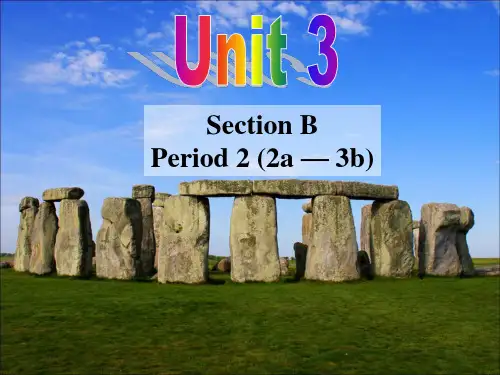
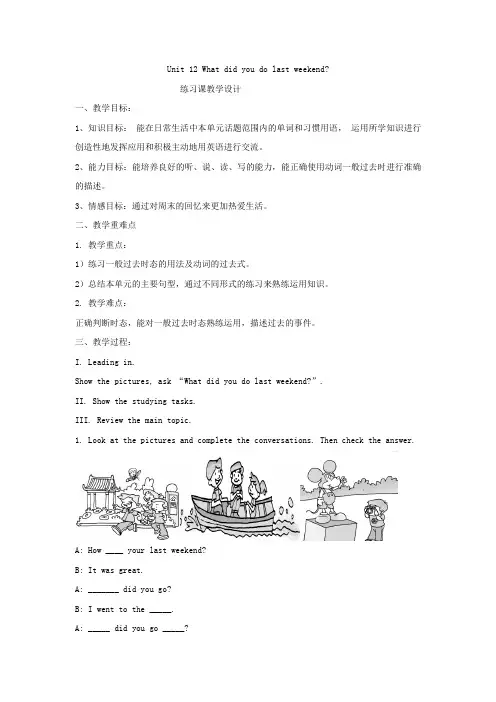
Unit 12 What did you do last weekend?练习课教学设计一、教学目标:1、知识目标:能在日常生活中本单元话题范围内的单词和习惯用语,运用所学知识进行创造性地发挥应用和积极主动地用英语进行交流。
2、能力目标:能培养良好的听、说、读、写的能力,能正确使用动词一般过去时进行准确的描述。
3、情感目标:通过对周末的回忆来更加热爱生活。
二、教学重难点1. 教学重点:1)练习一般过去时态的用法及动词的过去式。
2)总结本单元的主要句型,通过不同形式的练习来熟练运用知识。
2. 教学难点:正确判断时态,能对一般过去时态熟练运用,描述过去的事件。
三、教学过程:I. Leading in.Show the pictures, ask “What did you do last weekend?”.II. Show the studying tasks.III. Review the main topic.1. Look at the pictures and complete the conversations. Then check the answer.A: How ____ your last weekend?B: It was great.A: _______ did you go?B: I went to the _____.A: _____ did you go _____?B: I went with my classmates.A: ______ did you do there?B: We _____ ________ and _____ some photos.2. Make up a new conversation like above, tell us your last weekend activities.3. Watch the video and answer the questions.(1).What did Carol do on the weekend? Did she watch TV?(2).What did Steven do?(3).What did Jake do? How was his weekend?IV. Review the grammar.4. Talk about the grammar of this unit, fill in the blanks.一般过去时态的特殊疑问句。
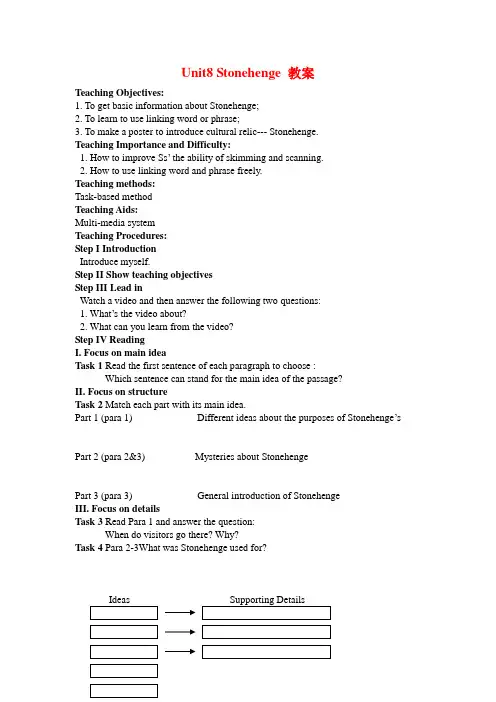
Unit8 Stonehenge 教案Teaching Objectives:1. To get basic information about Stonehenge;2. To learn to use linking word or phrase;3. To make a poster to introduce cultural relic--- Stonehenge.Teaching Importance and Difficulty:1. How to improve Ss’ the ability of skimming and scanning.2. How to use linking word and phrase freely.Teaching methods:Task-based methodTeaching Aids:Multi-media systemTeaching Procedures:Step I IntroductionIntroduce myself.Step II Show teaching objectivesStep III Lead inWatch a video and then answer the following two questions:1. What’s the video about?2. What can you learn from the video?Step IV ReadingI. Focus on main ideaTask 1 Read the first sentence of each paragraph to choose :Which sentence can stand for the main idea of the passage?II. Focus on structureTask 2 Match each part with its main idea.Part 1 (para 1) Different ideas about the purposes of Stonehenge’s Part 2 (para 2&3) Mysteries about StonehengePart 3 (para 3) General introduction of StonehengeIII. Focus on detailsTask 3 Read Para 1 and answer the question:When do visitors go there? Why?Task 4 Para 2-3What was Stonehenge used for?Thinking :So many ideas they have. Which idea do you agree with? If not, please give your idea and supporting idea.In my opinion,As far as I’m concerned,From my point of view.Because, for, while, when, so, etc.Task 5 Read Para 4 and answer:1. What is one of the greatest mysteries about Stonehenge?2. Who built Stonehenge ?Step 5 SummaryStonehenge, a rock circle, is _______one of Britain’s most famous historical places, _____ one of its greatest mysteries. As for its mysteries, different people have different opinions.Most historians thought Stonehenge was a temple _____ancient leaders communicated with the gods._______, others believed it might be a kind of calendar _____ it directly related to the sun. ____some other people hold the view that the stones can prevent illness _____ keeping people healthy. Although no one is sure what Stonehenge was used for, they agree that the position of the stones must be for a special purpose. In 2001, some volunteers tried to build another Stonehenge, _____ failed.Step 6 Design a posterSuppose the topic of your project-based English learning(英语研究性学习) is “Stonehenge”. Please design a poster to present your findings about it.Step 7 Homework★Read the passage again and find some useful expressions.★★Polish(润色) your poster and put it up behind the classroom.★★★Surf the Internet to get more information about Stonehenge.。
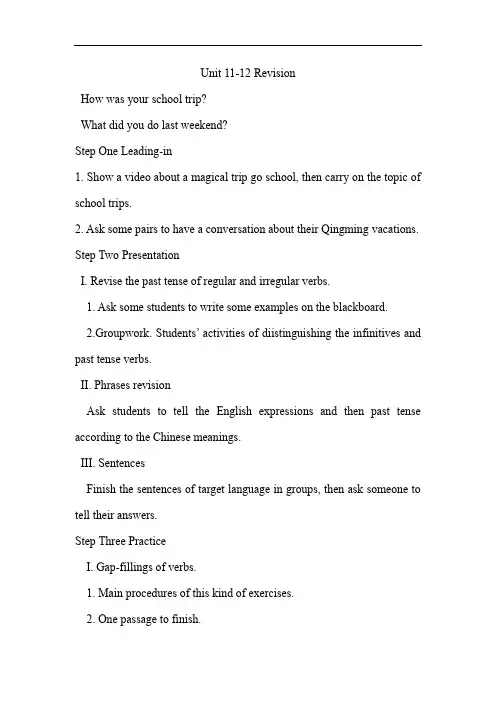
Unit 11-12 RevisionHow was your school trip?What did you do last weekend?Step One Leading-in1. Show a video about a magical trip go school, then carry on the topic of school trips.2. Ask some pairs to have a conversation about their Qingming vacations. Step Two PresentationI. Revise the past tense of regular and irregular verbs.1. Ask some students to write some examples on the blackboard.2.Groupwork. Students’ activities of diistinguishing the infinitives and past tense verbs.II. Phrases revisionAsk students to tell the English expressions and then past tense according to the Chinese meanings.III. SentencesFinish the sentences of target language in groups, then ask someone to tell their answers.Step Three PracticeI. Gap-fillings of verbs.1. Main procedures of this kind of exercises.2. One passage to finish.II. Writing1.Topic about an exciting trip (past event or activity )2.Ask students to write and then show in front of the class.3.Give evaluationStep Four Homework1.Exercises2.After finish the wring, share with group members.本班学生的整体基础尚可,有学优生也有学困生。

学情分析初四年级的学生已经逐渐脱离了幼稚,开始探索生活和自然的奥秘。
他们热衷于生活中的许多未解之谜,也热衷于想象。
本节课的所讲的巨石阵,恰巧可以填补学生的想象空间,让他们在石头阵的基础上,增加对大自然的热爱和兴趣,进而更加热爱生活。
效果分析通过本节课的学习,学生们基本了解了巨石阵的历史,以及从过去到现在人们对它的来历的各种推测,掌握了关于巨石阵的基本知识和用途。
但是在进行脑图分析复述的时候,由于文本内容过多,部分学生可能在记忆上出现了偏差,以至于无法记忆完整。
总体上达到了预期效果。
教材分析本篇课文是关于英国巨石阵的一篇文章,文本内容很长,学生接受起来有一定难度,作为一节阅读课,在课前让学生了解一些相关的基础知识是必须的,比如它的历史渊源以及相关的地理信息。
当堂练习1 不仅汤姆去过长城,杰克也去过。
Not only Tom ______ ______ Jack ______ ever been to the Great Wall.2 _____ you don’t fel well, you had better stay at home .A: Though B: Whether C: As3 The teacher ________ many mistakes in my homework.A: point out B: point at C: point to4.We arrived _____ Beijing yesterday.We arrived _____ the bus stop five minutes late.5. 一种很多种各种各样的不同种类的有点对某人、某物友好课后反思本节课所讲的课文文本内容较长,学生在接受起来的时候有一定难度,尤其是在进行复述时,由于内容较多,出现遗忘或者复述不全。
这本身与我的课件设计也有很大关系:课件过难,在一定程度上打消了学生学习的积极性;另一方面,在环节上,每个流程之间缺少有效的过渡,虽然是按照读前读中和读后设计的,但是整体性不够强,结构过于松散,因此无法集中学生的注意力,此外,在时间的分配上,出现了前松后紧,这也是教学设计不够严密的原因,在今后的教学中,还是要立足于根本,从学生的实际出发,吃透学生的学情,能准确预估学生的学习能力,预测他们能学会什么,哪里会遇到困难等等。
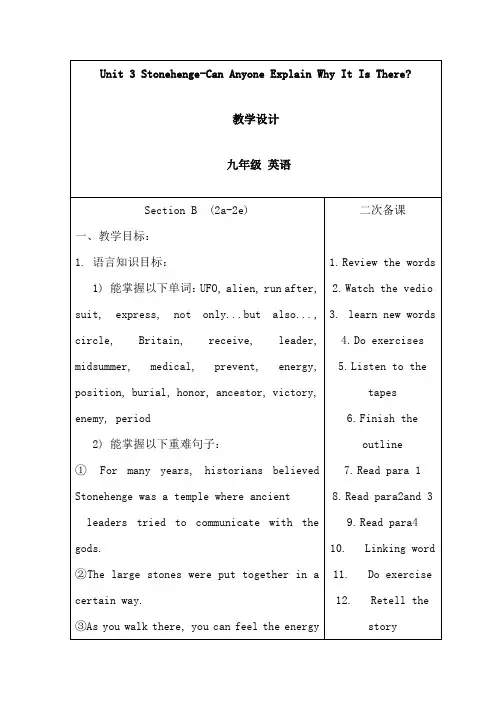
Unit 3 Stonehenge-Ca Anyone Explain Why It Is There?学情分析九年级英语1、学生年龄特点分析九年级学生年龄比较大,不善于表现自己,上课声音比较小,有点腼腆。
2、学生已有知识经验分析针对本节课或本单元的教学内容,确定学生需要掌握哪些知识、具备哪些生活经验,然后分析学生是否具备这些知识经验。
通过看视频扩大知识储备,可以适当降低教学难度和教学方法。
3、学生学习能力和学习风格分析针对本班学生中学习能力突出的尖子生和学习能力较弱的学习困难学生,因材施教、采取变通灵活的教学策略。
优等生可以复述本文章,能力弱的通过小组活动降低难度。
4、学生学习风格分析本班级整体学习气氛浓厚。
通过提出挑战性的问题、合作等方式尽量取学生之长、补其之短。
因此,在本学科的教学过程中,在注重启发引导,培养学生分析、概括能力的同时,更要注重教学方法的灵活性,通过任务型教学法,情景交际法,全身反应教学法等,激发学生学习的兴趣,让学生乐于接受,易于接受。
教师教的多,学生练得较少。
其中读的较少,没有充分利用时间让学生一边读一边思考。
有些题难度较大,应该降低难度.Unit 3 Stonehenge-Ca Anyone Explain Why It Is There?效果分析这节课容量大、节奏快、效率高,充分体现了以教师为主导,以训练为主线,体现了六种要求进课堂,体现了教师教学方式与学生学习方式的转变。
使课堂成为情感的课堂,唤醒了学生的学习欲望;成为互动的课堂,学生主动参与,自主学习,师生共同探讨。
本节课争取建构起一种互动、体验、快乐的多元课堂。
一、激发学习兴趣,让学生想学。
“知之者不如好之者好之者不如乐之者,”兴趣是最好的老师。
本节课教师主要通过以下方法激发学生兴趣,调动学生学习的积极性。
1.导入激趣。
转轴拨弦三两声,未成曲调先有情。
一个好的课堂导入,是建立师生感情的第一座桥梁,可以使学生自然而然地进入学习新知识的情境,并能激发学生的兴趣和强烈的求知欲,在最短的时间内,使学生进入最佳的学习状态。
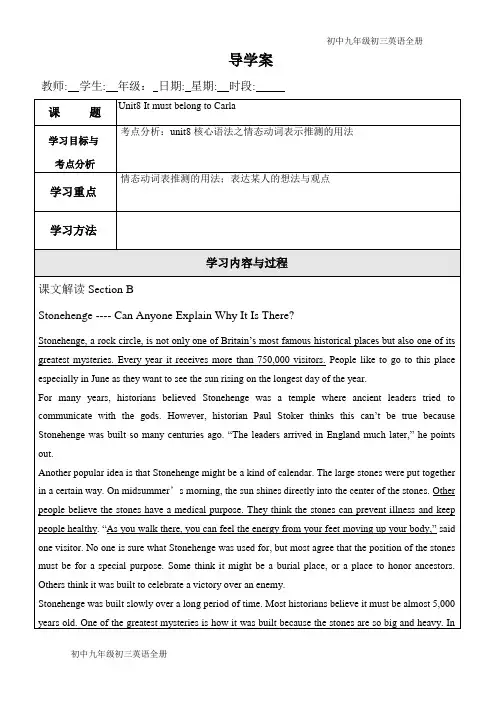
导学案教师: 学生: 年级:日期: 星期: 时段:课题第Unit8 It must belong to Carla考点分析:unit8核心语法之情态动词表示推测的用法学习目标与考点分析情态动词表推测的用法;表达某人的想法与观点学习重点学习方法学习内容与过程课文解读Section BStonehenge ---- Can Anyone Explain Why It Is There?Stonehenge, a rock circle, is not only one of Britain’s most famous historical places but also one of its greatest mysteries. Every year it receives more than 750,000 visitors. People like to go to this place especially in June as they want to see the sun rising on the longest day of the year.For many years, historians believed Stonehenge was a temple where ancient leaders tried to communicate with the gods. However, historian Paul Stoker thinks this can’t be true because Stonehenge was built so many centuries ago. “The leaders arrived in England much later,” he points out.Another popular idea is that Stonehenge might be a kind of calendar. The large stones were put together in a certain way. On midsummer’s morning, the sun shines directly into the center of the stones. Other people believe the stones have a medical purpose. They think the stones can prevent illness and keep people healthy. “As you walk there, you can feel the energy from your feet moving up your body,” said one visitor. No one is sure what Stonehenge was used for, but most agree that the position of the stones must be for a special purpose. Some think it might be a burial place, or a place to honor ancestors. Others think it was built to celebrate a victory over an enemy.Stonehenge was built slowly over a long period of time. Most historians believe it must be almost 5,000 years old. One of the greatest mysteries is how it was built because the stones are so big and heavy. In2001, a group of English volunteers tried to build another Stonehenge, but th ey couldn’t. “We don’t really know who built Stonehenge,” says Paul Stoker. “And perhaps we might never know, but we do know they must have been hardworking ---- and great planners!”要点详解1.Why do you think the man is running?本句由“疑问词+do you think+其他”构成的特殊疑问句。
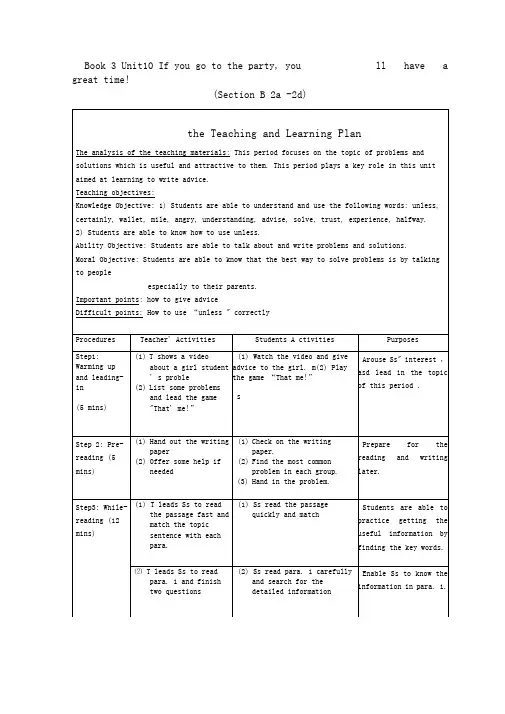
Book 3 Unit10 If you go to the party, you ll have a great time!(Section B 2a -2d)学情分析作为八年级的学生,具备了一定的词汇量和读写能力,可以进行U10SB这样篇幅的阅读任务。
同时也具备了根据上下文来猜测词义的能力。
写作方面,可以就某个话题陈述观点并进行论证。
这也是与课程标准的要求相吻合的。
同时他们愿意和同桌讨论问题,愿意参与小组活动。
因此设计了一系列符合他们年龄段特点的活动。
激发他们的兴趣,拓展他们的思维,培养他们的团队合作精神。
作为八年级的学生,正值叛逆的青春期。
通过和家长们的交谈了解到,在家里不愿意和父母交流,有悄悄话或者秘密后不愿意和父母分享,更多的是愿意和朋友们倾诉,为此家长们也很苦恼。
通过这篇阅读,更多的需要情感方面的升华。
让他们通过阅读,通过课堂上的参与交流,感受到父母一直都在,父母一直是最关心他们的人,以后有问题要和父母交流,我认为这是本节课最大的影响。
效果分析带着问题观看视频比直接播放视频再提问效果会更好也更高效。
学生在看视频的过程中,会不断思考提前出示的问题,视频播放完了,答案也在头脑中形成了。
以后会继续沿用这样的方法。
“That' s me!?游戏的设计,效果非常明显。
本来略显拘谨的学生,因为听懂了问题,并且发现自己也同样有这样的问题而兴奋地站了起来。
在这样的站起--坐下--站起的过程中,为后续谈论问题做好了铺垫。
“ Mind-map” 的设计更好地帮助了学生理清思维,掌握文章的脉络,不失为理解文章的一个利器。
以后会更加注重让学生自己设计思维导图,那样会更有利于训练他们的思维,提升他们的归纳概括的能力。
另外一个出效果的环节是:提炼阅读文章中表达观点的句子,然后出示在大屏幕上。
在写作环节,学生可以借鉴。
一是避免学生难以下手的问题;二是可以学以致用,让学生有成就感,激励他们更好地去阅读,做更多的有效输出。
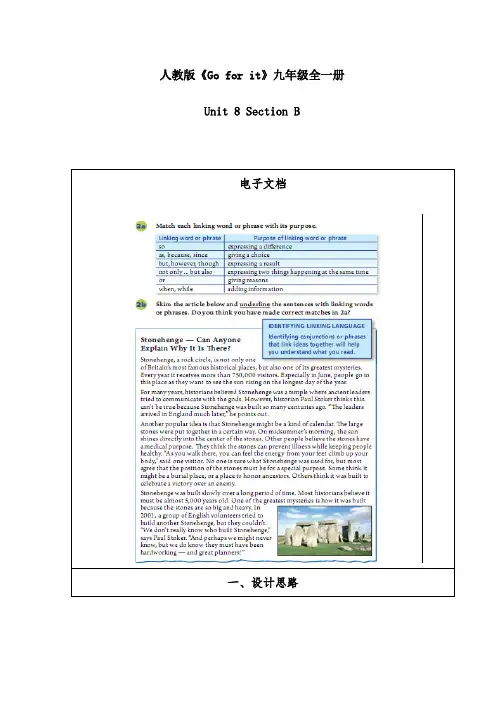
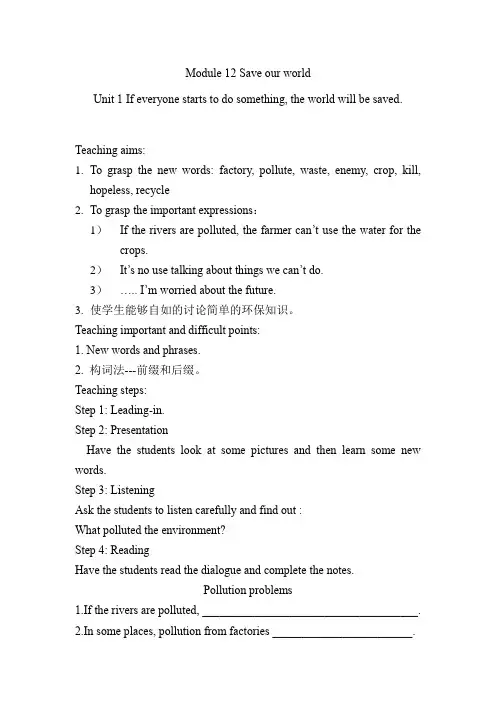
Module 12 Save our worldUnit 1 If everyone starts to do something, the world will be saved.Teaching aims:1.To grasp the new words: factory, pollute, waste, enemy, crop, kill,hopeless, recycle2.To grasp the important expressions:1)If the rivers are polluted, the farmer can’t use the water for the crops.2)It’s no use talking about things we can’t do.3)….. I’m worried about the future.3.使学生能够自如的讨论简单的环保知识。
Teaching important and difficult points:1. New words and phrases.2. 构词法---前缀和后缀。
Teaching steps:Step 1: Leading-in.Step 2: PresentationHave the students look at some pictures and then learn some new words.Step 3: ListeningAsk the students to listen carefully and find out :What polluted the environment?Step 4: ReadingHave the students read the dialogue and complete the notes.Pollution problems1.If the rivers are polluted, _____________________________________.2.In some places, pollution from factories ________________________.3. The cars on the roads ______________________________________.What the students can do4. Support a green school: every class ___________ which can be ___________________. Then the school _____________to help students ____________________.5. Students learn _____________________. That means __________. Step 6: Practice1.Have students listen again and try to read the conversations in groups.2.Have students act out in front of the class.Step 7: SummaryStep 8: Exercises in class1.Have students complete the passage with the correct form of the wordsin the box.2.Call the answers from the whole class.Step 9: Work in pairsHave the students list the pollution problems in your place. Choose one problem and say what should be done about it.For example:----The air pollution in our city is getting worse. What can we do to stop it?---- I think we can ride our bicycles to school more.Homework:Write a passage about how to control pollution and how save our world.本单元主要学习构词法,因此需要学生具备一定的单词量,能够在教师的引导下,发现某些单词的规律,比如前后缀等。
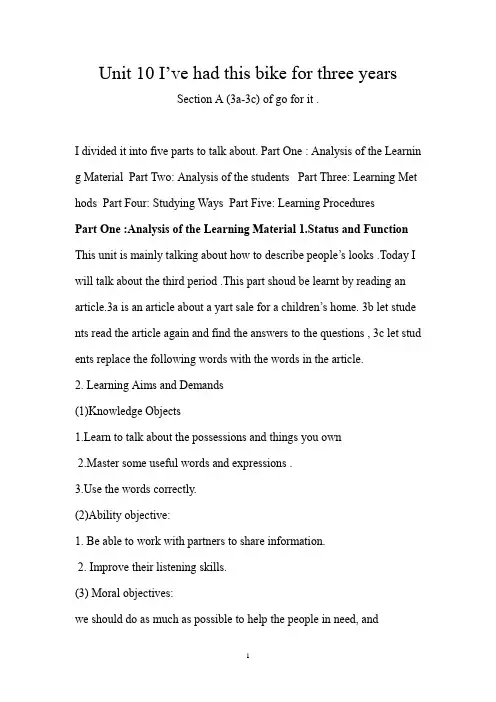
Unit10I’ve had this bike for three yearsSection A(3a-3c)of go for it.I divided it into five parts to talk about.Part One:Analysis of the Learnin g Material Part Two:Analysis of the students Part Three:Learning Met hods Part Four:Studying Ways Part Five:Learning ProceduresPart One:Analysis of the Learning Material1.Status and Function This unit is mainly talking about how to describe people’s looks.Today I will talk about the third period.This part shoud be learnt by reading an article.3a is an article about a yart sale for a children’s home.3b let stude nts read the article again and find the answers to the questions,3c let stud ents replace the following words with the words in the article.2.Learning Aims and Demands(1)Knowledge Objects1.Learn to talk about the possessions and things you own2.Master some useful words and expressions.e the words correctly.(2)Ability objective:1.Be able to work with partners to share information.2.Improve their listening skills.(3)Moral objectives:we should do as much as possible to help the people in need,andremember that”Helping others is helping ourselves.”(四)Learning key points and difficult pointkey pointThe key vocabulary and some new phrases.difficult pointsThe target language and how students can use the target language proficiently.Part Two:Analysis of the studentsThe students have learned English for about one year so far.They can und erstand some simple sentences and some simple articles.The students hav e taken a great interest in English now.And what they’er learning is relate d to the daily life and practical,so they have much to share.Part Three:Teaching MethodsIn this lesson,I’ll mainly use the“task-based”teaching method,andit will be used in the whole lesson.I think it’s helpful to develop the Ss’t hought.I’ll also use“situation communicating”method.It can provide en ough reading and speaking situations for Ss.I think good teaching metho ds are the keys to success.Part Four:Guide of Learning WaysIn order to guide the Ss better,develop the Ss’abillities,in this lesson, the Ss will learn how to be a good language learner,and how to commun icate with others.It will be very helpful for their learning in the future.I t hink good studying ways can help the Ss to be good language learners.Part Five:Learning Procedures一,导学领航New words1. bedroom n. 卧室2. railway n. 铁路;铁道3. junior adj. 地位 (或职位、级别) 低下的junior high school 初级中学e.g. We could give the job to somebody junior.我们可以把这份工作交给职位较低的人。
教学过程:Step1 : Leading-in 对话导入:1、教师和同学们进行自由对话:教师问学生如何上学,由此导入本单元的题目 How doyou get to school ?设计意图:设计场景,激发学生兴趣。
给学生留下深刻印象。
Step 2 : Revise the knowledgeHow does he get to school ? How does she get to school ?How do they get to school ?设计意图:教师通过复习以上问题,让同学们重新巩固乘坐交通工具的说法。
Step 3 : Memory challenge and Watch a video设计意图:检查学生们对所学短语的掌握情况,以及通过观看视频,了解正确的发型。
Step 4 : Learn the phrases and sentences设计意图:The river is very big.And the water runs too quickly for boats.There is no bridge between their school and the village.为学习新课文做铺垫。
Step 5 : Play the video .设计意图:为学习 crossing the river to school 做铺垫。
Step 6 :Learn“the crossing the river to school”设计意图:通过出示一些问题来了解学生对文章的理解情况。
Step 7 : Learn to help others!(学会帮助他人)设计意图:对学生加强思想教育。
在课堂教学中渗入思想教育。
Step8 Homework : Do exercises设计意图:巩固本单元所学知识。
学情分析七年级学生在小学六年级学过一些到校的学习方式,对于常见的到校方式还是比较熟悉的,也基本上会表达。
Unit 4 An old man tried to move the mountains.Section B 2a--2e教学设计【学习目标】通过本节课的学习,学生能:1.通过图片或语境理解scene, stepmother, wife, husband,whole, unless等词汇和短语的意义。
2.通过扫读,明确童话剧本的主要特点(有场景和对话);通过寻读和悟读,逐步了解文本信息。
3.通过故事复述和表演理解故事的发展情节。
4.通过对文本的学习,对中外童话故事产生兴趣,增强学生的文化意识和阅读兴趣。
【学习过程】Leading-in:Guessing & Pairwork设计意图:激活学生的已有知识,激发学生的阅读动机,同时渗透新单词的学习,逐步达成目标11.Skimming:Skim the whole passage and find out the text type.设计意图:引导学生浏览语篇,达成目标2:通过扫读,明确戏剧剧本的主要特点2. Reading★Read Para. 1Why does the wife tell her husband to leave the children to the forest?设计意图:了解故事的发生背景,达成目标1:理解部分单词和短语的意义;达成目标2:对文本逐步理解★Read Scene one—Scene sevenHow many times do Hansel and Gretel go to the forest?设计意图:进一步了解文本的相关知识,达成目标2:逐步了解文本信息★Read Scene one—Scene four & RetellWhat does Hansel go out to get in the moonlight?Why does he do in the moonlight?设计意图:进一步了解文本,达成目标2:逐步了解文本信息;达成目标3:通过故事复述理解故事的发展情节★Read Scene five—Scene seven & ActWhat will Hansel drop this time?Why can’t they see the bread?What do they find?设计意图:进一步了解文本,达成目标2:逐步了解文本信息;并且为目标3中的表演做好铺垫Group work设计意图:通过表演达成目标3:通过表演理解故事的发展情节,并且逐步达成目标4【家庭作业】必做:Finish reading the rest part of Hansel and Gretel.选做:Try to act the whole fairy tale play and read more fairy tales.设计意图:通过扩大阅读了解完整的故事情节,并逐步达成目标4学情分析八年级学生已经具备了一定的语言基础及语言表达能力,同时大部学生对英语有着比较浓厚的兴趣。
“学历案”:基于“三因素理论模型”下初中英语的教学设计—以人教版初中英语《Stonehenge-Can Anyone Explain Why It Is There?》为例邱慧康发布时间:2023-05-30T00:48:49.269Z 来源:《教学与研究》2023年6期作者:邱慧康[导读] “教-学-评一致性的三因素理论模型”,即学教一致性,教评一致性和评学一致性,是当前新课程标准(2022年版)增强的指导性意见,不仅明确了为何教和教什么,而且也强化了怎么教。
“学历案”是将“三因素理论模型”应用于课堂教学一种切实可行的工具,即是对学生学习进行预设的方案。
学习目标、学习过程、评价任务是学历案的三个主体部分。
文章以《Stonehenge-Can Anyone Explain Why It IsThere?》为例,探索“三因素理论模型下阅读课“学历案”的设计,以此来达到学生学习效果和教师反思的提升。
湖州市练市镇第一中学摘要:“教-学-评一致性的三因素理论模型”,即学教一致性,教评一致性和评学一致性,是当前新课程标准(2022年版)增强的指导性意见,不仅明确了为何教和教什么,而且也强化了怎么教。
“学历案”是将“三因素理论模型”应用于课堂教学一种切实可行的工具,即是对学生学习进行预设的方案。
学习目标、学习过程、评价任务是学历案的三个主体部分。
文章以《Stonehenge-Can Anyone Explain Why It Is There?》为例,探索“三因素理论模型下阅读课“学历案”的设计,以此来达到学生学习效果和教师反思的提升。
关键词:“学历案” “三因素理论模型” 初中英语“教-学-评一致性三因素理论模型”是由华东师范大学课程与教学研究所崔允漷教授及研究人员从理论分析的视角概括出来的。
该模型包含“学教一致性”“教评一致性”和“评学一致性”三个因素,它们相互作用,和而不同,构成“教-学-评一致性”的内涵(以下简称“三因素理论模型”)“学历案”的基本要素包括:学习主题、学习目标、评价任务、学习过程、巩固练习、学后反思。
学情分析
初四年级的学生已经逐渐脱离了幼稚,开始探索生活和自然的奥秘。
他们热衷于生活中的许多未解之谜,也热衷于想象。
本节课的所讲的巨石阵,恰巧可以填补学生的想象空间,让他们在石头阵的基础上,增加对大自然的热爱和兴趣,进而更加热爱生活。
效果分析
通过本节课的学习,学生们基本了解了巨石阵的历史,以及从过去到现在人们对它的来历的
各种推测,掌握了关于巨石阵的基本知识和用途。
但是在进行脑图分析复述的时候,由于文本内容过多,部分学生可能在记忆上出现了偏差,以至于无法记忆完整。
总体上达到了预期效果。
教材分析
本篇课文是关于英国巨石阵的一篇文章,文本内容很长,学生接受起来有一定难度,作为一节阅读课,在课前让学生了解一些相关的基础知识是必须的,比如它的历史渊源以及相关的地理信息。
当堂练习
1 不仅汤姆去过长城,杰克也去过。
Not only Tom ______ ______ Jack ______ ever been to the Great Wall.
2 _____ you don’t fel well, you had better stay at home .
A: Though B: Whether C: As
3 The teacher ________ many mistakes in my homework.
A: point out B: point at C: point to
4.We arrived _____ Beijing yesterday.
We arrived _____ the bus stop five minutes late.
5. 一种
很多种
各种各样的
不同种类的
有点
对某人、某物友好
课后反思
本节课所讲的课文文本内容较长,学生在接受起来的时候有一定难度,尤其是在进行复述时,由于内容较多,出现遗忘或者复述不全。
这本身与我的课件设计也有很大关系:课件过难,在一定程度上打消了学生学习的积极性;另一方面,在环节上,每个流程之间缺少有效的过渡,虽然是按照读前读中和读后设计的,但是整体性不够强,结构过于松散,因此无法集中学生的注意力,此外,在时间的分配上,出现了前松后紧,这也是教学设计不够严密的原因,在今后的教学中,还是要立足于根本,从学生的实际出发,吃透学生的学情,能准确预估学生的学习能力,预测他们能学会什么,哪里会遇到困难等等。
课标分析
新课标始终要求突出学生的主体地位,
明确指出,英语课程要面向全体中学生,注重素质教育。
课程特别要强调要关注每个学生的情感,激发他们的学习兴趣,语言学习要从语法讲解中和单词的死记硬背中解脱出来,要通过创设良好的语言环境和提供大量语言实践的机会,使学生通过自己的体验、感知、实践、参与和交流,形成语感;在老师的引导下,通过观察、发现和归纳等方式,掌握语言的规律,形成有效的学习策略,通过交流与合作发展交流与合作的能力。